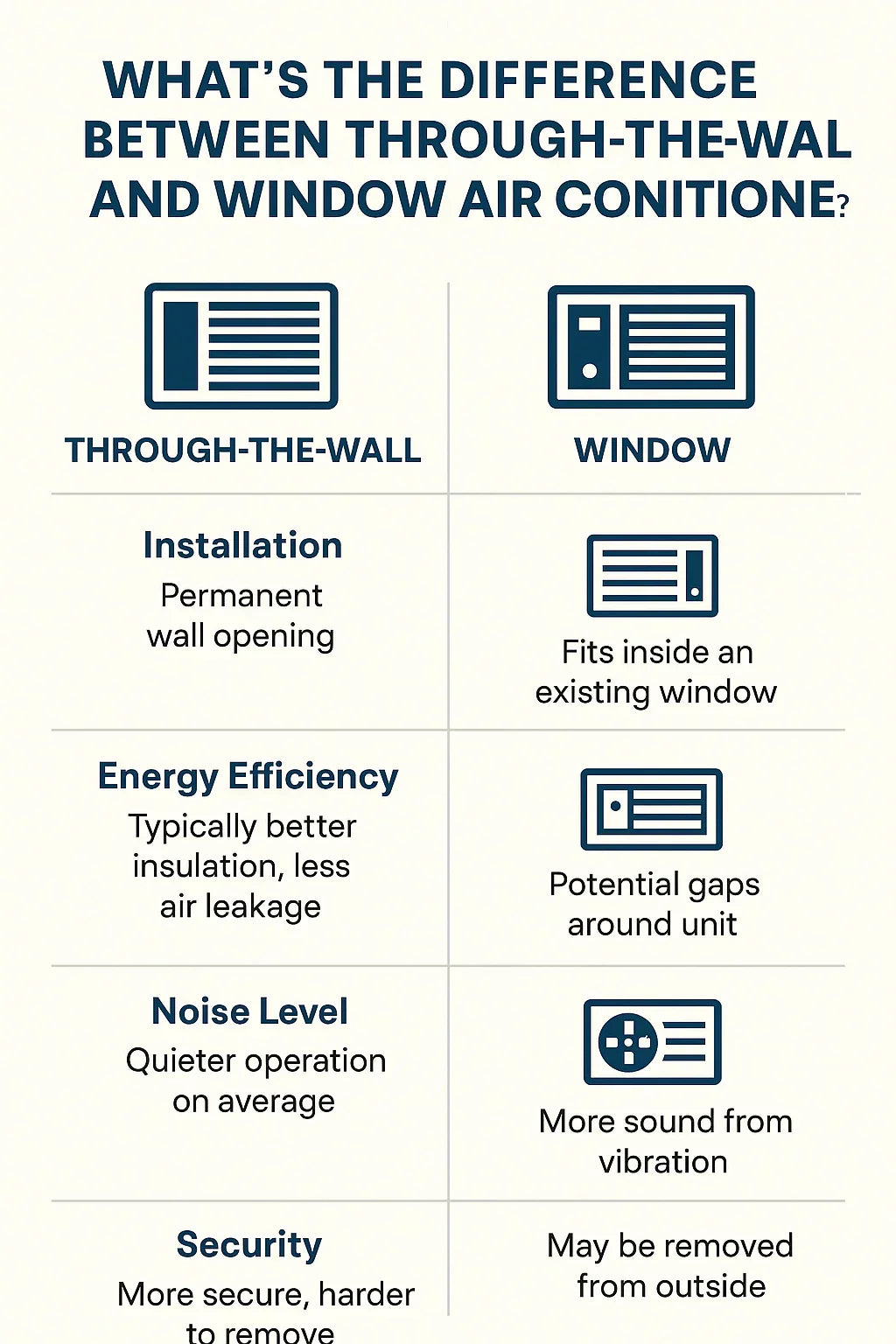If you’re deciding between a through-the-wall AC and a window air conditioner, understanding the differences will help you select the best option for your space, comfort, and long-term value.
Mike Sanders breaks down practical comparisons to guide your choice confidently.
📌 Quick Comparison
| Feature | Through-the-Wall AC | Window AC |
|---|---|---|
| Installation | Permanent, requires wall sleeve | Temporary, fits in window frame |
| Window Use | Keeps window free | Blocks window light/view |
| Energy Efficiency | Generally higher | Moderate |
| Noise Levels | Quieter indoors | Louder indoors |
| Heating Options | Often available (heat pump) | Rarely available |
| Cost | Higher upfront, lower long-term | Lower upfront |
| Maintenance | Accessible front filter | Accessible front filter |
| Resale Impact | Adds value if cleanly installed | No impact |
🧱 What Is a Through-the-Wall AC?
A through-the-wall AC is installed in an exterior wall using a wall sleeve, creating a permanent cooling and heating (if using a heat pump model) solution for a single room.
Benefits:
✅ Doesn’t block window light
✅ Quieter operation
✅ More secure, less risk of theft
✅ Energy-efficient, sealed installation
✅ Offers heating functionality (in some models)
Ideal for: Home offices, bedrooms, sunrooms, and apartments needing permanent cooling.
Further reading:
🪟 What Is a Window AC?
A window AC sits inside a window frame, venting hot air outside while cooling the room.
Benefits:
✅ Lower upfront cost
✅ Easy DIY installation and removal
✅ Portable, can be moved between rooms
✅ Great for renters or seasonal cooling
Ideal for: Short-term cooling needs, apartments, or homes where permanent installation isn’t possible.
Further reading:
🔊 Noise Level Comparison
✅ Through-the-Wall ACs: Quieter because the compressor is outside the wall cavity.
✅ Window ACs: Typically louder, especially on higher fan settings.
If using in a bedroom or office where quiet is a priority, through-the-wall ACs are the better choice.
⚡ Energy Efficiency Comparison
✅ Through-the-Wall ACs: Generally more energy-efficient due to a sealed installation that reduces drafts.
✅ Window ACs: Less efficient, especially if window seals are poor.
Look for Energy Star ratings in either type for best efficiency.
💰 Cost Comparison
✅ Through-the-Wall ACs:
-
Higher upfront cost ($600-$1,200 + installation)
-
Lower long-term energy and maintenance costs
-
Adds value to your home
✅ Window ACs:
-
Lower upfront cost ($150-$500)
-
Easy to install without professional help
-
No long-term home value impact
🛠️ Installation Differences
✅ Through-the-Wall ACs:
-
Requires cutting into an exterior wall
-
Needs a wall sleeve and professional installation for best results
-
Ideal for homeowners
✅ Window ACs:
-
Slides into a window frame
-
Secures with side panels and brackets
-
Ideal for renters or temporary cooling
Further reading:
🪟 Security and Aesthetic Impact
✅ Through-the-Wall:
-
Secure against intruders
-
Clean, flush appearance
✅ Window AC:
-
Can be removed from outside (security risk)
-
Blocks window light and view
-
May violate HOA or apartment restrictions
🏠 When Should You Choose a Through-the-Wall AC?
✅ You need permanent, reliable cooling for a specific room.
✅ You want to maintain window views.
✅ You value quieter operation.
✅ You want the option for heating with a heat pump.
✅ You own your home or plan to stay long-term.
🏠 When Should You Choose a Window AC?
✅ You need a budget-friendly, temporary cooling option.
✅ You’re renting and cannot install permanent systems.
✅ You want seasonal cooling that can be removed in winter.
✅ You want a DIY installation without structural changes.
✅ Conclusion: Choose Based on Your Needs
Both through-the-wall ACs and window ACs offer reliable cooling, but your best choice depends on your:
-
Space constraints
-
Budget
-
Long-term vs. short-term needs
-
Noise sensitivity
-
Heating requirements
If you need quiet, permanent, and efficient cooling, a through-the-wall AC like the Amana PBH073J35AA is ideal. For flexibility and lower upfront costs, a window AC is practical for renters and seasonal needs.
In the next topic we will know more about: Energy Efficiency and Tax Credits: Do Wall Units Qualify?







